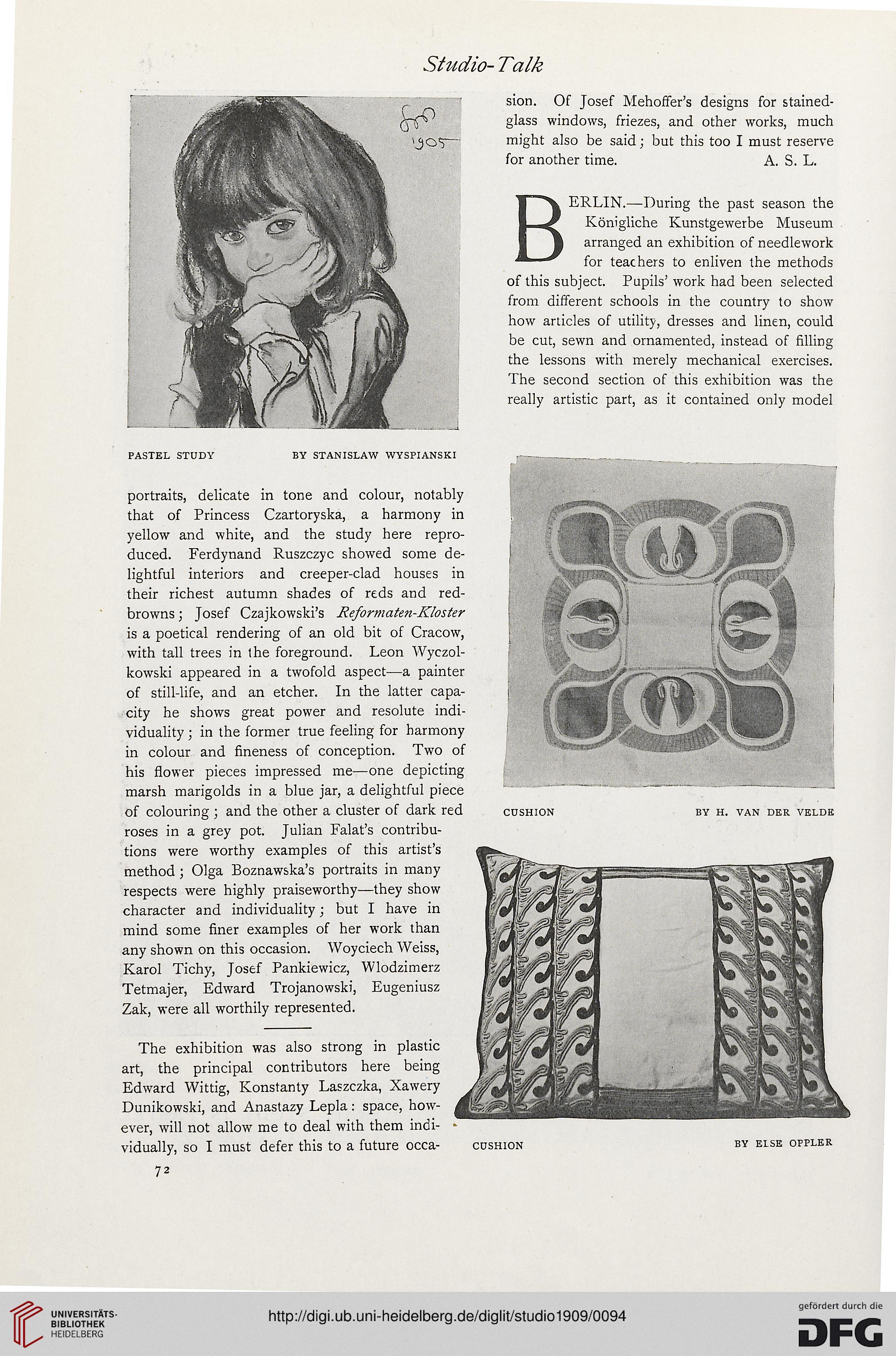Studio- Talk
sion. Of Josef Mehoffer’s designs for stained-
glass windows, friezes, and other works, much
might also be said ; but this too I must reserve
for another time. A. S. L.
BERLIN.—During the past season the
Königliche Kunstgewerbe Museum
arranged an exhibition of needlework
for teachers to enliven the methods
of this subject. Pupils’ work had been selected
from different schools in the country to show
how articles of utility, dresses and linen, could
be cut, sewn and ornamented, instead of filling
the lessons with merely mechanical exercises.
The second section of this exhibition was the
really artistic part, as it contained only model
BY ELSE OPPLER
PASTEL STUDY BY STANISLAW WYSPIANSKI
BY H. VAN DER VELDE
portraits, delicate in tone and colour, notably
that of Princess Czartoryska, a harmony in
yellow and white, and the study here repro-
duced. Ferdynand Ruszczyc showed some de-
lightful interiors and creeper-clad houses in
their richest autumn shades of reds and red-
browns ; Josef Czajkowski’s Reformaten-Kloster
is a poetical rendering of an old bit of Cracow,
with tall trees in the foreground. Leon Wyczol-
kowski appeared in a twofold aspect—a painter
of still-life, and an etcher. In the latter capa-
city he shows great power and resolute indi-
viduality ; in the former true feeling for harmony
in colour and fineness of conception. Two of
his flower pieces impressed me—one depicting
marsh marigolds in a blue jar, a delightful piece
of colouring ; and the other a cluster of dark red
roses in a grey pot. Julian Falat’s contribu-
tions were worthy examples of this artist’s
method ; Olga Boznawska’s portraits in many
respects were highly praiseworthy—they show
character and individuality ; but I have in
mind some finer examples of her work than
any shown on this occasion. Woyciech Weiss,
Karol Tichy, Josef Pankiewicz, Wlodzimerz
Tetmajer, Edward Trojanowski, Eugeniusz
Zak, were all worthily represented.
The exhibition was also strong in plastic
art, the principal contributors here being
Edward Wittig, Konstanty Laszczka, Xawery
Dunikowski, and Anastazy Lepla : space, how-
ever, will not allow me to deal with them indi-
vidually, so I must defer this to a future occa-
CUSHION
72
sion. Of Josef Mehoffer’s designs for stained-
glass windows, friezes, and other works, much
might also be said ; but this too I must reserve
for another time. A. S. L.
BERLIN.—During the past season the
Königliche Kunstgewerbe Museum
arranged an exhibition of needlework
for teachers to enliven the methods
of this subject. Pupils’ work had been selected
from different schools in the country to show
how articles of utility, dresses and linen, could
be cut, sewn and ornamented, instead of filling
the lessons with merely mechanical exercises.
The second section of this exhibition was the
really artistic part, as it contained only model
BY ELSE OPPLER
PASTEL STUDY BY STANISLAW WYSPIANSKI
BY H. VAN DER VELDE
portraits, delicate in tone and colour, notably
that of Princess Czartoryska, a harmony in
yellow and white, and the study here repro-
duced. Ferdynand Ruszczyc showed some de-
lightful interiors and creeper-clad houses in
their richest autumn shades of reds and red-
browns ; Josef Czajkowski’s Reformaten-Kloster
is a poetical rendering of an old bit of Cracow,
with tall trees in the foreground. Leon Wyczol-
kowski appeared in a twofold aspect—a painter
of still-life, and an etcher. In the latter capa-
city he shows great power and resolute indi-
viduality ; in the former true feeling for harmony
in colour and fineness of conception. Two of
his flower pieces impressed me—one depicting
marsh marigolds in a blue jar, a delightful piece
of colouring ; and the other a cluster of dark red
roses in a grey pot. Julian Falat’s contribu-
tions were worthy examples of this artist’s
method ; Olga Boznawska’s portraits in many
respects were highly praiseworthy—they show
character and individuality ; but I have in
mind some finer examples of her work than
any shown on this occasion. Woyciech Weiss,
Karol Tichy, Josef Pankiewicz, Wlodzimerz
Tetmajer, Edward Trojanowski, Eugeniusz
Zak, were all worthily represented.
The exhibition was also strong in plastic
art, the principal contributors here being
Edward Wittig, Konstanty Laszczka, Xawery
Dunikowski, and Anastazy Lepla : space, how-
ever, will not allow me to deal with them indi-
vidually, so I must defer this to a future occa-
CUSHION
72




